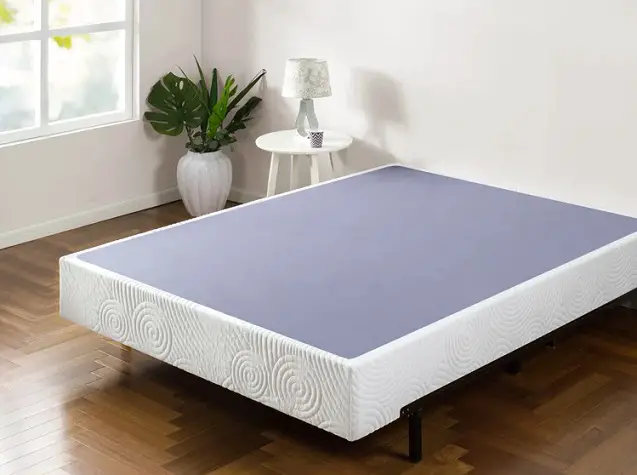A mattress needs to be supported to avoid damaging it and ensure the bed is more comfortable to sleep on. When you sleep on a firm bed, you will avoid having back pains and you will wake up rested well.
A Bunkie board is a mattress support system that is thin and put between the mattress and the bed frame. Different materials are used to make Bunkie boards and each one of them has different advantages and disadvantages over the other.
A Bunkie board may be screwed to the bed frame or may just be spread without requiring screwing. The fact that Bunkie boards are thin measuring only 2 inches and utmost 3 inches means they add very little weight to the bed frame.
Table of Contents
What Makes Bunkie Boards?
The materials making Bunkie beds vary but are mainly restricted to plywood, particleboards, solid wood, metal sheets, and plastic. Let’s look at each one of them.
1. Plywood Bunkie Boards
Plywood is made of thin sheets of wood that have been glued together. The sheets are lightweight and the resultant Bunkie board is lightweight. The technology used to make plywood makes the plywood Bunkie boards more expensive than the other boards.
Compared to particleboard Bunkie boards, plywood boards last longer and is less likely to disintegrate as the sheets are connected at angles and are continuous.
The main drawback of plywood Bunkie boards is that they are easily damaged by moisture and water and cannot hold as much weight as a solid board Bunkie board.
2. Particleboard Bunkie Boards
These are made from wood particles such as sawdust, wood chips, and sawmill shavings. This may be termed as waste but glue is added and the mixture is heat compressed to form the particle boards.
Usually, Urea-formaldehyde glue or phenol-formaldehyde glue is used to hold the particles together. These are toxic materials that may cause illness when one is exposed to them. The glues are prone to gassing especially when new.
The other disadvantage of particleboards is that they are heavy compared to plywood Bunkie boards. The boards are likely to disintegrate with time as the glue holding the particles becomes weak over time.
3. Solid Wood Bunkie Boards
This as the name suggests is made of solid wood that has been made thin. They are heavier compared to plywood Bunkie boards but they have the advantage of being able to hold more weight than plywood or particleboard Bunkie boards.
Solid wood Bunkie boards are strong but they are likely to change their form depending on the environment. They have been observed to expand in humid conditions and contract in hot conditions.
This is a disadvantage as the expansion may cause friction with the bed frame and cause squeaky noises that may disturb your sleep.
Solid wood Bunkie boards may be affected by mites and you need to have the wood treated with chemicals to avoid mite infestation. The chemicals used for treatment may be toxic to the human body.
Solid wood is also affected by moisture and water and may start forming molds which may also be poisonous to the body.
4. Steel Bunkie Boards
They are the strongest Bunkie boards and hold the greatest weight compared to the other Bunkie boards. They are made of sheets of steel that have been joined together in a frame. It is unlikely to find a continuous plain sheet of steel making the Bunkie board.
The steel plates have gaps between them to reduce om weight and a sturdy clothing material is applied to the frame to prevent the mattress from sagging through the gaps in the slats.
Steel Bunkie boards are never affected by weather and will not change shape. They are long-lasting and do not break or disintegrate with time.
5. Plastic Bunkie Boards
These are made from strong plastic. They are lightweight and can hold much more weight than plywood Bunkie board. The plastic Bunkie boards are also cheaper compared to the other types of Bunkie boards.
Plastic Bunkie boards are made in such a way that it is easy to fold them and store them in limited spaces. This makes them more portable than all the other Bunkie boards.
The plastic Bunkie board is resistant to weather and cannot be infested by mice. It will last longer and with time, it will not disintegrate or break. Plastic does not react in water and therefore does not mold.
How Is The Bunkie Board Used?
Bunkie boards provide support to the mattress and will help the mattress from damage. When no bed frame is available, the Bunkie board will help in lifting the mattress off the ground. When the mattress is on the floor, it will be damaged by the dampened ground and start forming molds.
The bed frame is made with slats that may be widely spaced. The gaps between the slats may cause the mattress to sag. This is especially so with foam mattresses and latex mattresses. This sagging damages the mattress and makes your sleep uncomfortable.
To apply even support to the mattress on the bed frame, the Bunkie board is put on top of the frame before the mattress is put on.
Since the Bunkie board is thin, it will not add significant height to the bed and it is also lightweight and therefore not much weight addition.
If the Bunkie board is the type that needs to be screwed to the bed, you need to secure it in place before you add the mattress on top. Ensure you have the right size of the Bunkie bed for your bed size and mattress size.
Final Thoughts
The essence of adding a Bunkie bed, especially on the mattresses that are put on the ground and platform beds is to increase the airflow. Increased airflow ensures that molds don’t form in the mattresses, especially in foam mattresses.
A Bunkie board can also be added to the box spring to ensure the springs do not damage the mattress, especially where the box spring is old and worn out.
Irrespective of the material making the Bunkie board, they are lightweight and add little weight to your bed frame.

